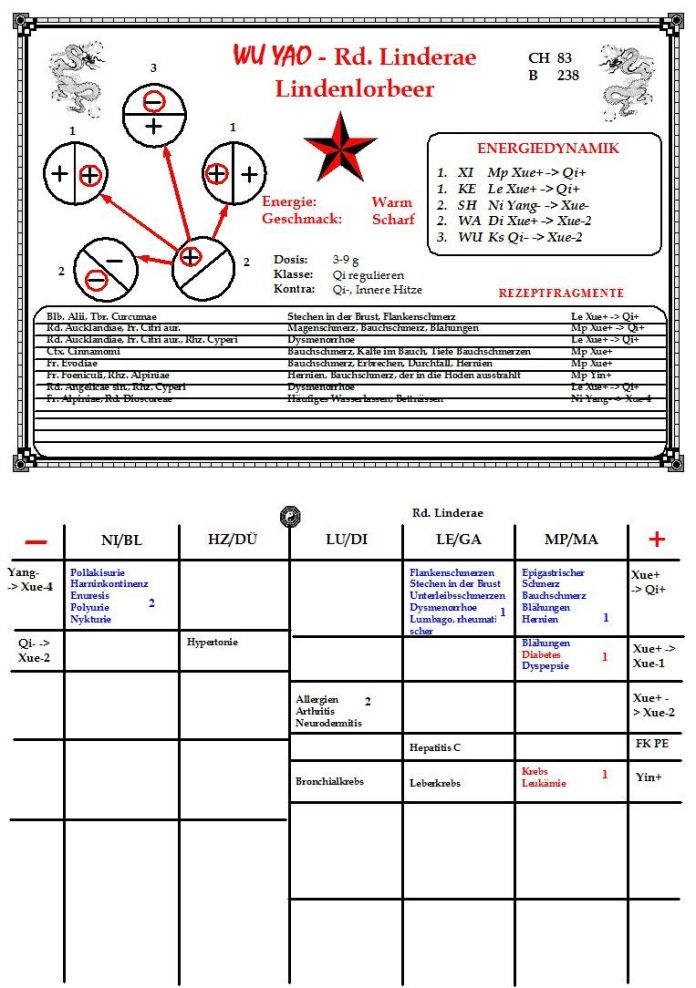
Morus, Ctx. rad. – SANG BAI PI
Dosis: 15-30g/Tag
Cortex Mori radicis wirkt wie Folium Mori in erster Linie beim metabolischen Syndrom (Diabetes Typ2, Hypertonie, Adipositas, Hypercholesterinämie).
Es erhöhen die Fähigkeit der Zellen mit widrigen Umständen regulatorisch umzugehen indem die Bildung und Ablagerung von toxischen Stoffwechselprodukten gemindert wird, die ihrerseits zu Entzündungen und Minderfunktionen führen. Dies gilt in erster Linie bei den schnell sich teilenden und den empfindlichen Zellen (Haut, Gefässe, Nerven), da sie von den beschriebenen degenerativen Prozessen am stärksten betroffen sind.
In diesem Sinne ist auch die Wirkung bei Krebs zu verstehen.
Die Wurzelrinde ist ein wichtiges Mittel zur Vorbeugung und Heilung von degenerativen zivilisations- und altersbedingten Krankheiten, die heute für 90% aller Todesfälle verantwortlich sind.
Eine Besonderheit ist im Gegensatz zu Folium Mori die Wirkung auf das Immunsystem. Hier kommt es zu einer regulatorischen Wirkung bei Allergien und Asthma durch die Beseitigung der Ablagerungen durch Aktivierung des Stoffwechsels. Es sind die Ablagerungen, die das Immunsystem mobilisiert. Einmal sensibilisiert reagiert es über schon bei kleinen Reizen und Allergien oder das atopische Syndrom entstehen.
- Metabolisches Syndrom
1.1. Diabetes
Hypoglycemic effects of hot water extracts from Folium Mori (Mulberry leaves, Morus alba L., China and Japan) or Cortex Mori Radicis (Morus alba L., China) were observed in fasted and nonfasted STZ-induced diabetic mice at a single dose of 200 mg/kg (i.p.)
1.2. Adipositas
1.2.1 Anti-obesity effect of Morus bombycis root extract: anti-lipase activity and lipolytic effect
Morus bombycis root extract exhibited strong anti-lipase activity, with an IC(50) value of 2.07mug/ml. In differentiated adipocytes and adipose tissues, the extract increased lipolytic effects such as decreased intracellular triglyceride and the release of glycerol.
1.3. Hypertonie
These results suggest that chronic treatment with MK extract exerts an antihypertensive effect in SHRs, and its direct vasorelaxant, negative inotropic actions, and anti-oxidant properties may contribute to reduce the elevated blood pressure
1.4. Hypercholesterinämie
Thus, it can be concluded that the consumption of MRBF-2 and (MRBF-3, in some extent) fractions of M. alba L. root bark 70% alcohol extract may act as a potent hypocholesterolemic nutrient and powerful antioxidant via the inhibition of LDL atherogenic modifications and lipid peroxides formation in hypercholesterolemic rats.
- Immunsystem
2.1. Allergi
The present results strongly suggest that MBE exerts an anti-allergic effect, both in vitro and in vivo by inhibiting the Lyn and Syk pathways in mast cells. Therefore, MBE may be useful for the treatment of allergic diseases, including atopic dermatitis and allergic asthma
These results suggested that HEMA inhibits the compound 48/80- or anti-CGG IgE-induced mast cell activation and its inhibitory effects on mast cell activations were favorably comparable to disodium cromoglycate. And HEMA is a candidate for effective therapeutic tools of allergic diseases.
2.2. Asthma
CMR exerts anti-allergic effect via enhancement of CD4(+)CD25(+)Foxp3(+) regulatory T cells and inhibition of Th2 cytokines in a mouse asthma model as a potent anti-asthmatic agent
- Krebs
3.1. Leukämie
These results suggested that albanol A induces apoptotic cell death in HL60 via both the cell death receptor pathway by stimulation of death receptor, and the mitochondrial pathway by Topo II inhibition through caspase-2 activation. Therefore, albanol A may be a promising lead compound for developing an effective drug for treatment of leukaemia
3.2. Krebs
3.2.1. Cortex mori extract induces cancer cell apoptosis through inhibition of microtubule assembly
Overall, the water extract of CM induces apoptosis of tumor cells by inhibiting microtubule assembly
- Karies
4.1. Kuwanon G: an antibacterial agent from the root bark of Morus alba against oral pathogens
The bactericidal test showed that kuwanon G completely inactivated S. mutans at the concentration 20 microg/ml in 1 min. Kuwanon G also significantly inhibited the growth of other cariogenic bacteria such as Streptococcus sobrinus and Streptococcus sanguis, and Porpyromonas gingivalis causing periodontitis.
- Herpes simplex
5.1. Antiviral flavonoids from the root bark of Morus alba L.
Leachianone G showed potent antiviral activity (IC(50) = 1.6 microg/ml), whereas mulberroside C showed weak activity (IC(50) = 75.4 microg/ml) against herpes simplex type 1 virus (HSV-1).
TCM
Ein Vergleich des Wirkspektrums von Ctx. Mori radicis, wie er sich durch die Analyse wissenschaftlicher Studien ergibt, und Benskys TCM-Pharmakopoe ergibt grosse Unterschiede:
Cornus erscheint laut TCM-Quellen als Mittel bei hitzigen Infektionskrankheiten.
Die Wirkung auf innere Krankheiten wie dem metabolischen Syndrom bleibt fast ganz aussen vor.
Die 5-Elementeanalyse bildet die Energiedynamik von Ctx. Mori wie folgt ab:
Blau bedeutet : TCM-Quellen
Grün bedeutet: TCM-Quellen und Studien
Schwarz : Studien
Rot: Studien Hauptwirkung
Zum Verständnis der Abkürzungen des Schaubildes siehe
Struktur – und Wandlungsmodell der chinesischen Medizin
http://www.chinesischemedizin.com/CMS/index.php/struktur-und-wandlungsmodell.html

Diskussionen
Es gibt noch keine Kommentare.